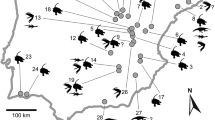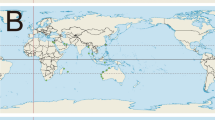Abstract
Gars (Lepisosteidae) are ray-finned fishes with controversial relationships to other actinopterygian lineages. When fossil taxa are considered, gars are grouped with Mesozoic macrosemiids and ‘semionotids’ in the Semionotiformes, but the intra-relationships within this order are still elusive. Here, the evolutionary history of gars is reinvestigated using a set of well-preserved extinct semionotiform taxa in a phylogenetic analysis. Results indicate that the gar lineage roots in a clade of Late Jurassic–Cretaceous semionotiform fishes. The closest relatives to gars were plant-eating and detritivorous freshwater fishes. The occurrence of semionotiform remains in Early and early Late Cretaceous continental deposits worldwide possibly reflects an important radiation of this group, comparable to the present-day diversification of cypriniforms. Other Late Triassic to Early Cretaceous semionotiform taxa are gathered in a single clade with weakly supported internal nodes, pointing out the necessity to better understand the osteology of these fishes.


Similar content being viewed by others
References
Arratia G, Schultze H-P (1999) Semionotiform fish from the Upper Jurassic of Tendaguru. Mitt Mus Natkd Berl Geowiss 2:135–153
Cavin L (2010) The Late Jurassic ray-finned fish peak of diversity: biological radiation or preservational bias? In: Nelson JS, Schultze H-P, Wilson MVH (eds) Origin and phylogenetic interrelationships of teleosts. Honoring Gloria Arratia. Dr. Friedrich Pfeil, Munich, pp 111–121
Cavin L, Suteethorn V (2006) A new Semionotiform (Actinopterygii, Neopterygii) from Upper Jurassic–Lower Cretaceous deposits of North-East Thailand, with comments on the relationships of Semionotiforms. Palaeontology 49:339–353. doi:10.1111/j.1475-4983.2006.00539.x
Forey P, Kitching IJ (2000) Experiments in coding multistate characters. In: Scotland RW, Pennington RT (eds) Homology and systematics. Taylor and Francis, New York, pp 54–80
Forey PL et al. A new species of Lepidotes (Actinopterygii: Semionotiformes) from the Cenomanian (Upper Cretaceous) of Morocco. Palaeontographica Electronica (in press)
Gallo V (2005) Redescription of Lepidotes piauhyensis Roxo and Löfgren, 1936 (Neopterygii, Semionotiformes, Semionotidae) from the ?Late Jurassic–Early Cretaceous of Brazil. J Vertebr Paleontol 25:757–769. doi:10.1671/0272-4634(2005)025[0757:ROLPRA]2.0.CO;2
Gardiner BG, Maisey JG, Littlewood DTJ (1996) Chapter 6. Interrelationships of basal neopterygians. In: Stiassny MLJ, Parenti LR, Johnson GD (eds) Interrelationships of fishes. New York, Academic, pp 117–146
Grande L (2005) Phylogenetic study of gars and closely related species, based mostly on skeletal morphology. The resurrection of Holostei. In: Poyato-Ariza FJ (ed) Fourth international meeting on Mesozoic fishes—systematics, homology and nomenclature, extended abstracts. Servicio de Publicaciones de la Universidad Autónoma de Madrid/UAM Ediciones, Spain, pp 119–121
Hurley IA, Mueller RL, Dunn KA, Schmidt EJ, Friedman M, Ho RK, Prince VE, Yang Z, Thomas MG, Coates MI (2007) A new time-scale for ray-finned fish evolution. Proc R Soc B 274:489–498. doi:10.1098/rspb.2006.3749
Huelsenbeck JP, Ronquist F (2001) MRBAYES: Bayesian inference of phylogeny. Bioinformatics 17:754–755. doi:10.1093/bioinformatics/17.8.754
Inoue JG, Miya M, Tsukamoto K, Nishida M (2003) Basal actinopterygian relationships: a mitogenomic perspective on the phylogeny of the “ancient fish”. Mol Phylogenet Evol 26:110–120. doi:10.1016/S1055-7903(02)00331-7
Kammerer CF, Grande L, Westneat MW (2006) Comparative and developmental functional morphology of the jaws of living and fossil gars (Actinopterygii: Lepisosteidae). J Morph 267:1017–1031. doi:10.1002/jmor.10293
Kearney M, Clark JM (2003) Problems due to missing data in phylogenetic analyses including fossils: a critical review. J Vert Palaeontol 23:263–274. doi:10.1671/0272-4634(2003)023[0263:PDTMDI]2.0.CO;2
Lewis PO (2001) A likelihood approach to estimating phylogeny from discrete morphological character data. Syst Biol 50:913–925. doi:10.1080/106351501753462876
López-Arbarello A, Sferco E New semionotiform (Actinopterygii: Neopterygii) from the Late Jurassic of southern Germany. J Syst Palaeontol (in press)
Maddison DR (1991) The discovery and importance of multiple islands of most-Parsimonious trees. Syst Zool 40:315–328
Maisey JG (1991) Araripelepidotes Silva Santos, 1985. In: Maisey JG (ed) Santana fossils. An illustrated atlas. TFH, Neptune City, pp 118–123
McCune AR (1996) Biogeographic and stratigraphic evidence for rapid speciation in semionotid fishes. Paleobiology 22:34–48
Müller J, Reisz RR (2006) The phylogeny of early eureptiles: comparing parsimony and Bayesian approaches to the investigation of a basal fossil clade. Syst Biol 55:503–511. doi:10.1080/10635150600755396
Near TJ, Miya M (2009) Actinopterygii. In: Hedges SB, Kumar S (eds) Timetree of life. Oxford University Press, Oxford, pp 328–331
Olsen PE, McCune AR (1991) Morphology of the Semionotus elegans group from the Early Jurassic part of the Newark Supergroup of Eastern North America with comments on the family Semionotidae (Neopterygii). J Vertebr Paleontol 11:269–292
Patterson C (1973) Interrelationships of holosteans. In: Greenwood PH, Miles RS, Patterson C (eds) Interrelationships of fishes. Academic, New York, pp 207–226
Schaeffer B, Dunkle DH (1950) A semionotid fish from the Chinle Formation, with consideration of its relationships. Amer Mus Novitates 1457:1–29
Swofford DL (2001) PAUP*: phylogenetic analysis using parsimony and other methods (software). Sinauer Associates, Sunderland
Thies D (1996) The jaws of Araripelepidotes temnurus (Agassiz, 1841) (Actinopterygii, Semionotiformes) from the Early Cretaceous of Brazil. J Vertebr Paleontol 16:369–373
Wenz S (1999) Pliodetes nigeriensis, gen. nov. et sp. nov., a new semionotid fish from the Lower Cretaceous of Gadoufaoua (Niger Republic): phylogenetic comments. In: Arratia G, Schultze H-P (eds) Mesozoic fishes 2—systematics and fossil record. Dr. Friedrich Pfeil, Munich, pp 107–120
Acknowledgements
This research was supported by the Swiss National Science Foundation (grant 200021-113980). I thank Peter L. Forey and Zerina Johanson (The Natural History Museum, London), Varavudh Suttethorn (Department of Mineral Resources, Thailand) and Jean Le Loeuff (Musée des Dinosaures, France) for access to fossil material under their care, and four anonymous referees for their significant comments and suggestions, which greatly improved the manuscript.
Author information
Authors and Affiliations
Corresponding author
Electronic supplementary material
Below is the link to the electronic supplementary material.
ESM Fig. 1
(PDF 123 kb)
Rights and permissions
About this article
Cite this article
Cavin, L. Diversity of Mesozoic semionotiform fishes and the origin of gars (Lepisosteidae). Naturwissenschaften 97, 1035–1040 (2010). https://doi.org/10.1007/s00114-010-0722-7
Received:
Revised:
Accepted:
Published:
Issue Date:
DOI: https://doi.org/10.1007/s00114-010-0722-7




